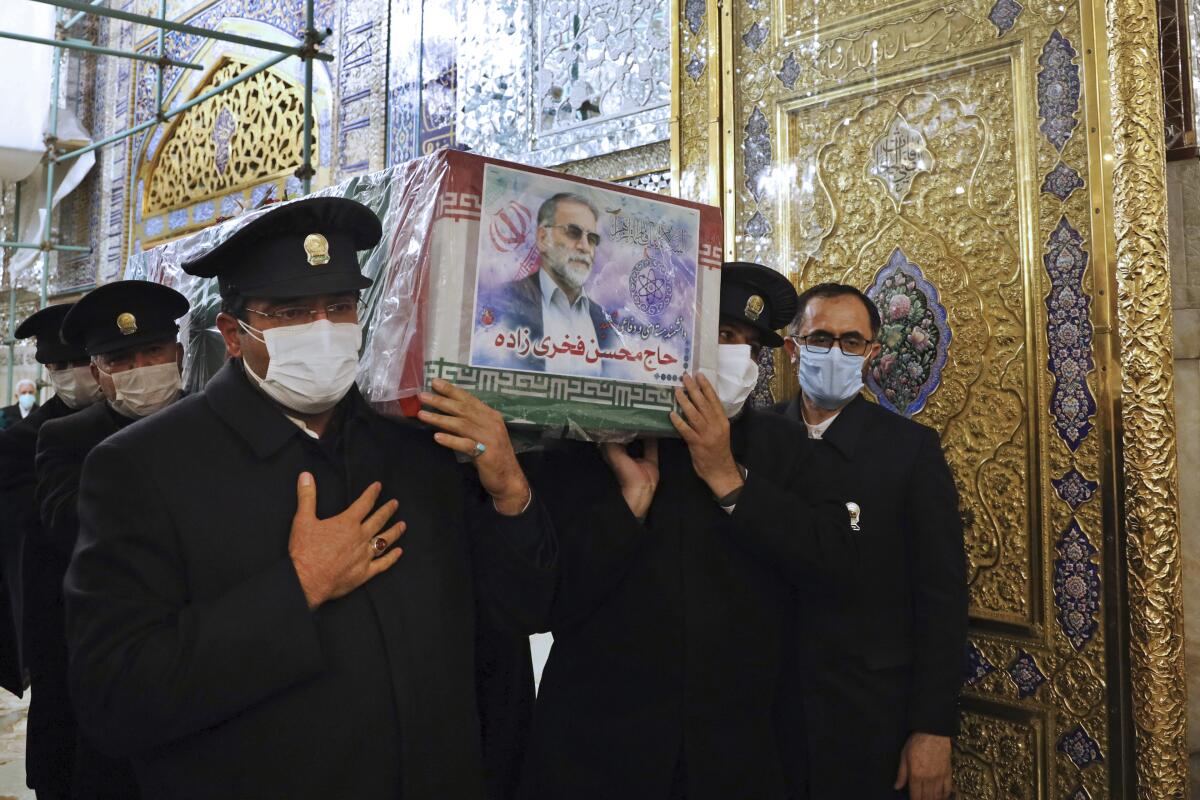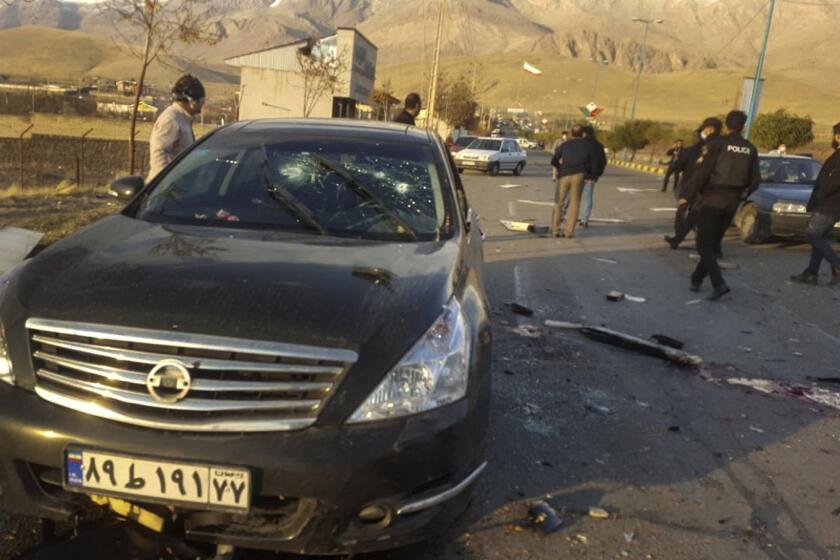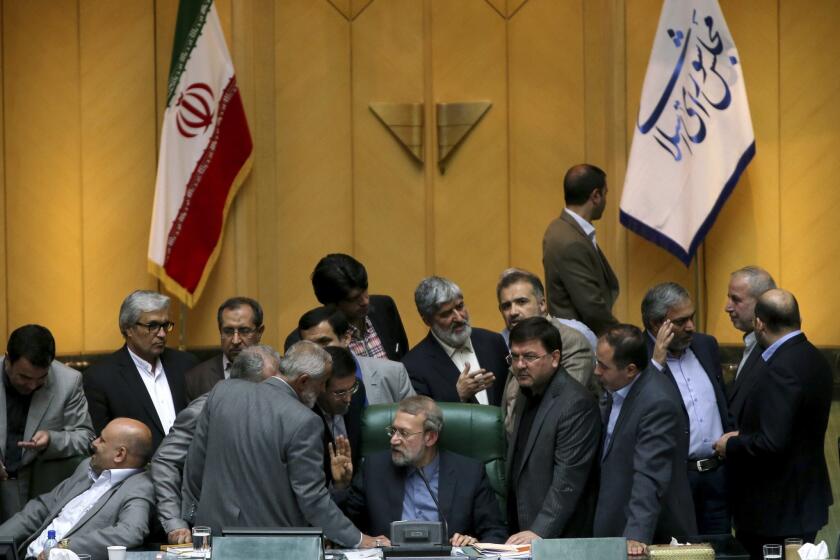Iran says Israel killed nuclear scientist remotely with ‘electronic devices’

- Share via
TEHRAN — A top Iranian security official Monday accused Israel of using “electronic devices” to remotely kill a scientist who founded the Islamic Republic’s military nuclear program in the 2000s.
Ali Shamkhani, the secretary of the country’s Supreme National Security Council, made the assertion at the funeral of Mohsen Fakhrizadeh-Mahabadi, where Iran’s defense minister separately vowed to continue the slain scientist’s work “with more speed and more power.”
Shamkhani’s remarks drastically change Iran’s account of Fakhrizadeh’s killing Friday. Authorities initially said that a truck exploded and gunmen then opened fire on the scientist, killing him. Iranian state television even interviewed a man on the night of the attack who described seeing gunmen open fire.
Israel, long suspected of killing Iranian nuclear scientists over the last decade, has declined to comment on the attack.
Fakhrizadeh headed Iran’s so-called AMAD program, which Israel and the West have alleged was a military operation looking at the feasibility of building a nuclear weapon. The International Atomic Energy Agency says that that “structured program” ended in 2003. U.S. intelligence agencies concurred with that assessment in a 2007 report.
Israel insists that Iran still harbors ambitions of developing nuclear weapons, pointing to Tehran’s ballistic missile program and research into other technologies. Iran has long maintained that its nuclear program is for peaceful purposes.
The assassination of a top nuclear scientist comes at a fragile moment for Iran’s government, which must balance calls for vengeance even as it waits for Biden to take office.
Just after Fakhrizadeh’s burial Monday, state television’s English-language Press TV said that a weapon recovered from the scene of the attack bore “the logo and specifications of the Israeli military industry.” The Arabic-language channel, Al-Alam, said that the weapons used were “controlled by satellite,” an assertion also made Sunday by the semi-official Fars news agency.
None of the outlets immediately offered evidence supporting their claims.
“Unfortunately, the operation was a very complicated operation and was carried out by using electronic devices,” Shamkhani told state TV. “No individual was present at the site.”
Satellite control of weapons is nothing new. Armed long-range drones rely on satellite connections for control by remote pilots. Remote-controlled gun turrets also exist, but typically see their operators connected by a hard line to cut down on the delay in commands being relayed. Israel uses such hard-wired systems along its border with the Hamas-controlled Gaza Strip.
While technically feasible in the attack on Fakhrizadeh, it wasn’t immediately clear if such a system had been used before, said Jeremy Binnie, the Mideast editor of Jane’s Defense Weekly.
“Could you set up a weapon with a camera which then has a feed that uses an open satellite communications line back to the controller?” Binnie said. “I can’t see why that’s not possible.”
It also raises the question of whether the truck that exploded during the attack was detonated afterward in order to destroy a satellite-controlled machine gun hidden inside. Iranian officials did not immediately acknowledge that. Someone on the ground would have had to set up the explosive device in the truck.
The killing of Mohsen Fakhrizadeh-Mahabadi is seen as part of the U.S. and Israel’s shadow war aimed at dismantling Iran’s nuclear weapons program.
Shamkhani also blamed the Iranian exile group Mujahedeen-e-Khalq for “having a role in this,” but he did not elaborate. The MEK, as the exile group is known, has been suspected of assisting Israeli operations in Iran in the past. The group did not immediately respond to a request for comment.
Monday’s funeral service took place at an outdoor portion of Iran’s Defense Ministry in Tehran, with officials including Revolutionary Guard chief Gen. Hossein Salami; the Guard’s Quds Force leader, Gen. Esmail Ghaani; the civilian nuclear program chief, Ali Akbar Sahei, and Intelligence Minister Mamoud Alavi. They sat apart from each other and wore masks because of the COVID-19 pandemic as reciters melodically read portions of the Quran and other religious texts.
An honor guard carried the casket containing Fakhrizadeh’s body.
Defense Minister Gen. Amir Hatami gave a speech after kissing the casket and putting his forehead against it. He said Fakhrizadeh’s killing would make Iranians “more united, more determined.”
“For the continuation of your path, we will continue with more speed and more power,” Hatami said.
Iran’s announcement that it will no longer abide by the most important limits in the landmark 2015 nuclear deal could place Tehran back on the pursuit of nuclear weapons.
Hatami also criticized countries that hadn’t condemned Fakhrizadeh’s killing, warning: “This will catch up with you someday.”
Overnight, the United Arab Emirates, which just reached a normalization deal with Israel, issued a statement condemning “the heinous assassination.” The UAE, home to Abu Dhabi and Dubai, warned that the killing “could further fuel conflict in the region.”
Last year, the UAE found itself in the middle of an escalating series of incidents between Iran and the U.S. Though long suspicious of Iran’s nuclear program, the UAE has said it wants to de-escalate the crisis. The country just started passenger air service to Israel, and Israelis are expected to vacation in the country over Hanukkah in the coming days.
Hatami also called the nuclear arsenal of the U.S. — and the stockpile of atomic bombs that Israel has long been suspected of holding — “the most dangerous threat against humanity.”
News Alerts
Get breaking news, investigations, analysis and more signature journalism from the Los Angeles Times in your inbox.
You may occasionally receive promotional content from the Los Angeles Times.
Mourners later buried Fakhrizadeh in the courtyard of Imamzadeh Saleh mosque in north Tehran.
In response to the killing, Iran’s parliament has begun a review of a bill that would stop inspections by the International Atomic Energy Agency. The nuclear watchdog has provided an unprecedented, real-time look at Iran’s civilian nuclear program following the country’s 2015 nuclear deal with world powers.
The deal has unraveled after President Trump’s unilateral 2018 withdrawal of the U.S. from the accord. Iran’s civilian atomic program has since continued its experiments and now enriches a growing uranium stockpile up to 4.5% purity.
That’s still far below weapons-grade levels of 90% purity, though experts warn that Iran now has enough low-enriched uranium to reprocess into fuel for at least two atomic bombs if it chose to pursue them. The proposed bill reportedly also would require Iran’s civilian atomic program to produce at least 265 pounds of uranium enriched to 20% — a short technical step to 90%.
Iran’s 290-seat parliament is dominated by hard-liners who likely would support the bill. It ultimately would have to be approved by Iran’s Guardian Council. Supreme Leader Ayatollah Ali Khamenei also has final say on all matters of state.
More to Read
Sign up for Essential California
The most important California stories and recommendations in your inbox every morning.
You may occasionally receive promotional content from the Los Angeles Times.












